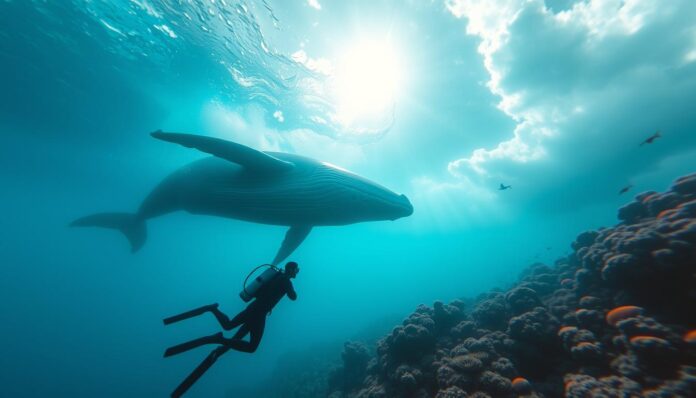Imagine meeting a creature that travels an amazing 3,100 miles every year across the ocean. The humpback whale is truly a wonder of the sea. It’s a dream come true for scuba divers to see these giants up close.
Scuba diving with humpback whales gives you a rare look at their world. These huge whales can grow up to 50 feet long and weigh over 44 tons. They make diving an adventure you’ll never forget.
Humpback whales are known for their big pectoral fins. This is why they’re called “big wings” in Greek. Their unique looks and behaviors make diving with them a special experience. It’s a chance to connect with the ocean’s most amazing creatures.
Key Takeaways – Diving with Humpback Whales
- Humpback whales migrate over 3,100 miles annually
- Male humpbacks can reach up to 50 feet in length
- Underwater whale experiences offer unique marine interactions
- Responsible diving practices are key for whale conservation
- Whale encounters need careful planning and respect for marine life
Introduction to Scuba Diving with Humpback Whales
Exploring the world of humpback whales is an amazing marine adventure. It connects us with nature’s most incredible creatures. These marine mammals live in every major ocean, giving us stunning chances to explore underwater and protect marine life.
Humpback whales are truly special. They have unique traits that amaze both marine fans and scientists. They migrate thousands of miles, from Antarctica to tropical areas like Tonga for breeding.
Understanding the Humpback Whale
These marine giants have traits that make diving with them unforgettable:
- Body length ranges from 39-52 feet
- Weight typically between 25-30 metric tons
- Known for complex vocalization and communication
- Perform spectacular breaching behaviors
Importance of Marine Conservation
“Protecting these magnificent creatures ensures future generations can experience their incredible marine presence.”
Marine conservation is key to saving humpback whale habitats. With only a few permits for whale interactions, responsible tourism is vital. In places like Tonga, strict rules govern whale encounters, including:
- Maximum of four swimmers per encounter
- 90-minute breaks between group interactions
- Guided experiences with licensed operators
The Thrill of Scuba Diving
Seeing humpback whales underwater is an unparalleled connection with marine life. Divers can see their graceful movements and social behaviors. Guides often suggest snorkeling over scuba diving to avoid disturbing whales.
A whale watching trip usually lasts 8-10 days. This gives us many chances to see humpback whales and support marine conservation.
Best Locations for Humpback Whale Diving
Exploring the world’s most remarkable destinations for whale watching tours requires careful planning. You need to understand humpback whale migration patterns. Each location offers unique experiences that allow divers to witness these magnificent marine creatures in their natural habitat.
Travelers seeking extraordinary underwater encounters have several world-class destinations to choose from. The diversity of locations ensures that whale enthusiasts can find their perfect marine adventure.
Top Destinations Worldwide
Asia:
- The Kingdom of Tonga: Located in the South Pacific, the Kingdom of Tonga is renowned for its exceptional humpback whale encounters. The calm and clear waters provide a perfect setting for diving alongside these gentle giants. The islands of Vava’u and Ha’apai are popular destinations for witnessing humpback whale courtship rituals and underwater displays.
- The Maldives: The Maldives, with its idyllic islands and abundant marine life, offers a remarkable opportunity to dive with humpback whales. From November to April, these waters become a gathering ground for humpback whales during their migration. Liveaboard trips in the Maldives provide a chance to explore various dive sites where encounters with humpback whales are possible.
- Mozambique: The warm waters of Mozambique attract humpback whales during their migration from the Antarctic. Places like Tofo, Ponta do Ouro, and Inhambane offer excellent diving opportunities to observe humpback whales, often accompanied by dolphins and other marine species.
- Dominican Republic: The Dominican Republic is known for its humpback whale sanctuary in the waters surrounding the Samaná Peninsula. From January to March, these waters become a haven for humpback whales, where they mate, give birth, and nurse their young. Diving in Samaná Bay provides an unforgettable chance to witness their incredible behaviors.
- Turks and Caicos: The islands of Turks and Caicos in the Caribbean are frequented by humpback whales during their migration. The marine parks around these islands offer divers an opportunity to encounter these majestic creatures while exploring the vibrant coral reefs and walls.
- Silver Bank, Dominican Republic: The Silver Bank, located off the coast of the Dominican Republic, is one of the world’s best destinations for up-close encounters with humpback whales. This submerged bank serves as a mating and breeding ground for humpback whales from January to April. Liveaboard trips to the Silver Bank provide a unique opportunity for extended, immersive interactions with these gentle giants.
- Norway: The coast of Norway is a remarkable destination for diving with humpback whales. The fjords of northern Norway attract these marine giants during the summer months, where they come to feed on herring. Witnessing humpback whales in the stunning Norwegian fjords is an awe-inspiring experience.
- The Kingdom of Tonga: As mentioned earlier, the Kingdom of Tonga in the South Pacific is a premier destination for humpback whale encounters. The crystal-clear waters, coupled with the chance to swim with humpback whale mothers and their calves, make it an unforgettable destination for underwater enthusiasts.
- Hawaii, USA: The waters surrounding the Hawaiian Islands are home to a variety of marine life, including humpback whales. From December to May, humpback whales migrate to these warm Pacific waters to breed and give birth. Diving off the coasts of Maui and the Big Island provides opportunities to observe these majestic creatures.
- Peninsula Valdes, Argentina: Peninsula Valdes, a UNESCO World Heritage site in Argentina, is a prime location for humpback whale encounters. Between May and December, humpback whales visit these waters to mate and give birth. Diving in the Golfo Nuevo and Golfo San José allows for remarkable encounters with these gentle giants.
It’s important to note that the timing and availability of humpback whale encounters may vary each year, and it’s advisable to check with local dive operators or tour providers for the best times to plan your dive in each specific region.
Each of these destinations offers a unique opportunity to witness the beauty and grace of humpback whales in their natural habitats. Whether you choose to dive in the azure waters of the Caribbean or the remote corners of Oceania, the encounters with these magnificent creatures will leave you with memories to cherish for a lifetime.
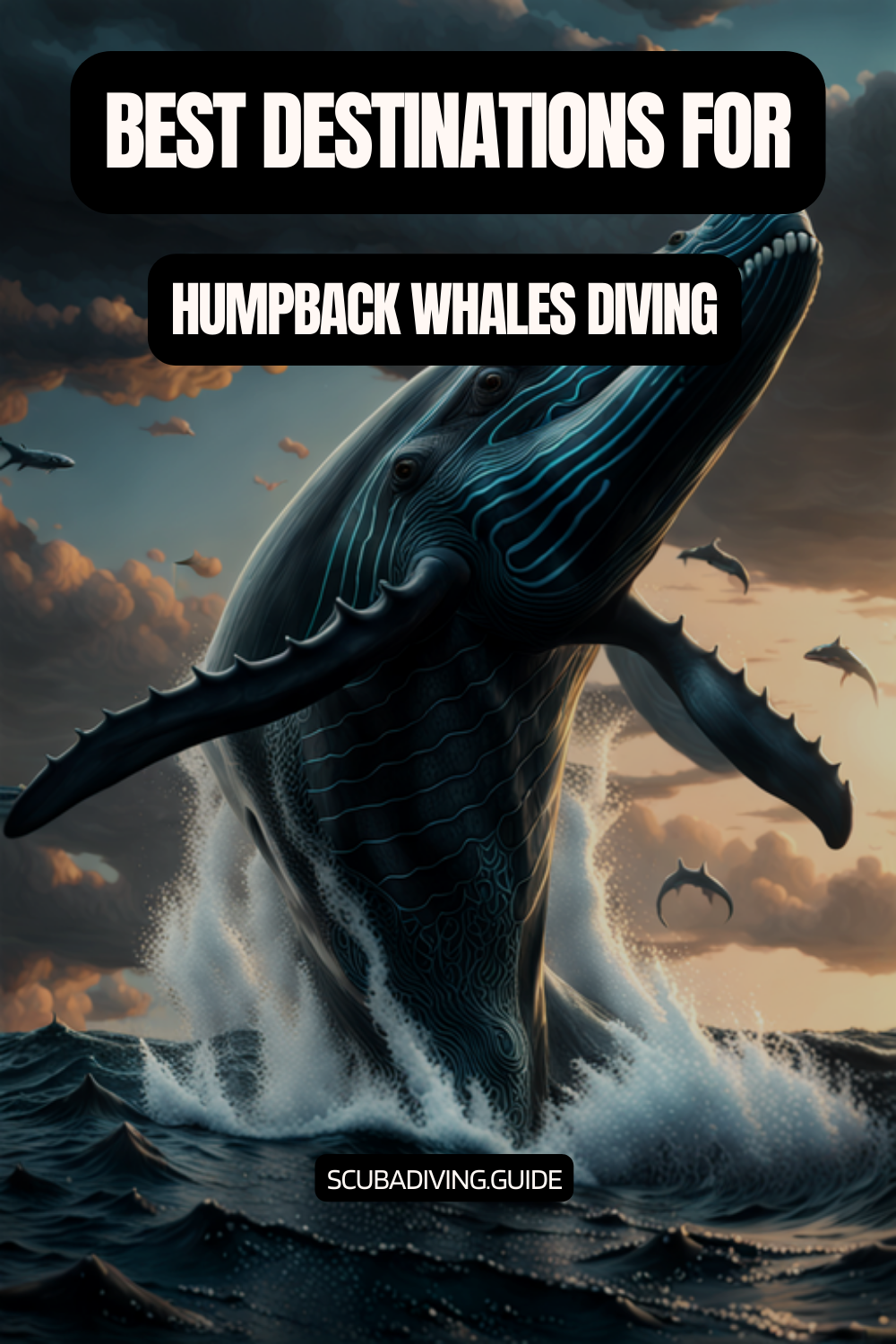
Seasonal Considerations
Understanding the timing of humpback whale migration is key for planning your diving expedition. Different regions offer unique seasonal windows for optimal whale encounters.
| Location | Peak Season | Water Temperature |
|---|---|---|
| Mo’orea, French Polynesia | July – November | 83-85°F (27-29°C) |
| Tonga | July – November | 75-80°F (24-27°C) |
| Silver Bank, Dominican Republic | January – April | 78°F (25°C) |
Local Regulations
Each destination has specific guidelines to protect marine life during whale watching tours. For instance, the Silver Bank restricts vessel numbers to less than 60 per week, ensuring minimal environmental impact.
“Responsible diving means respecting the whales’ natural environment and following local conservation regulations.”
Divers must obtain necessary permits and adhere to strict interaction guidelines. Scuba diving is often prohibited, with snorkeling being the preferred method of whale observation.
Preparing for Your Dive
Scuba diving with Humpback Whales needs careful planning and special knowledge. Whether you’re a seasoned diver or new to whale watching, knowing the right gear and safety rules is key. This ensures a great underwater experience.
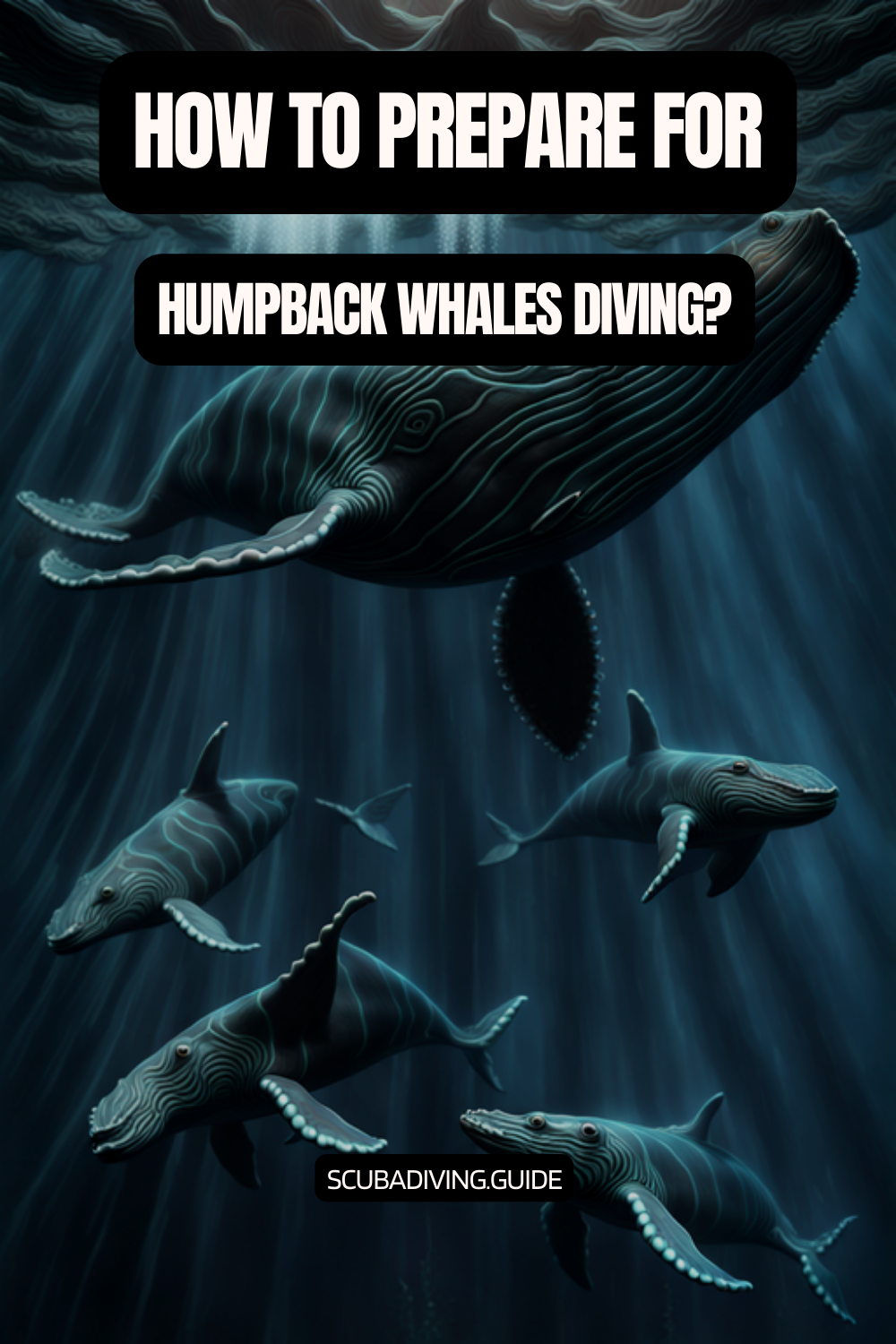
Essential Gear for Whale Diving
For safe and eco-friendly whale diving, you need specific gear. Your diving equipment should include:
- Thick wetsuit (5-7mm) for warmth
- High-quality underwater camera with wide-angle lens
- Specialized underwater communication devices
- Dive computer with long battery life
- Surface marker buoy (SMB) for visibility
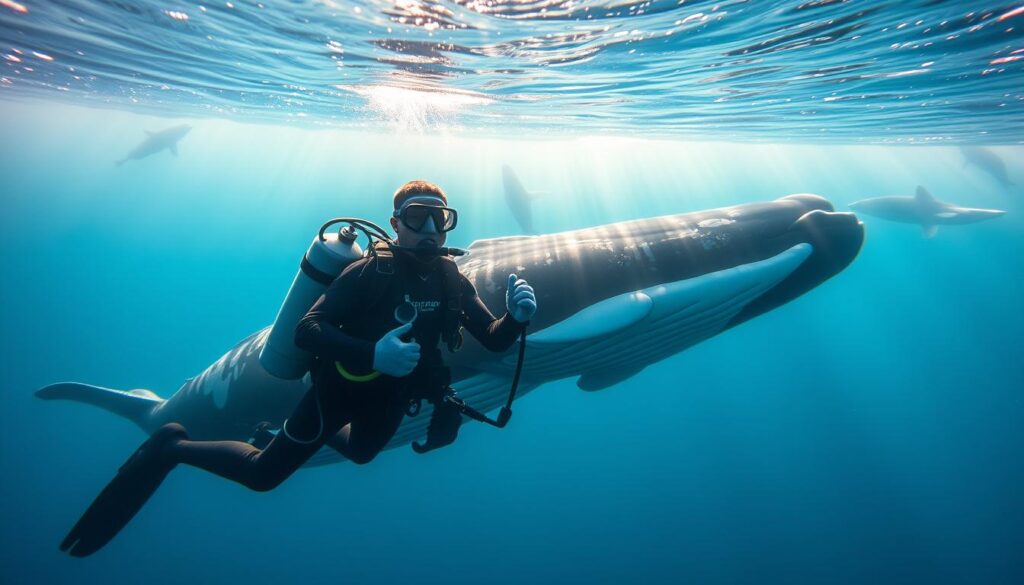
Safety Precautions to Follow
When diving with Humpback Whales, safety is top priority. Important rules to follow are:
- Keep a safe distance (at least 15 feet) from whales
- Move slowly and predictably underwater
- Never chase or touch marine mammals
- Follow local marine conservation laws
“Respect the ocean, and the ocean will respect you.” – Marine Conservation Expert
Understanding Dive Techniques
Whale-friendly diving needs special techniques. Neutral buoyancy and calm movements are key to not disturb these amazing creatures. Practice steady breathing and avoid sudden movements to be non-threatening underwater.
Experts suggest lots of practice in safe places before diving with humpback whales. Proper training keeps both divers and whales safe.
What to Expect During the Dive
Seeing humpback whales underwater is magical. It’s a chance to connect with marine life in a special way. These gentle giants make moments under the sea unforgettable, with chances for close-up interactions.
Before diving with humpback whales, you need to know a few things. You’ll see amazing underwater moments. These moments are shaped by the whales’ behavior and the sea around them.
Interaction Guidelines with Whales
When you dive with whales, there are important rules to follow:
- Keep at least 15 feet away
- Move slowly and in a straight line
- Avoid looking them in the eye
- Never touch or feed them
- Stay calm and quiet
Common Behavior of Humpback Whales
Humpback whales show interesting behaviors when you meet them underwater:
| Behavior | Description |
|---|---|
| Breaching | Jumping partially or fully out of the water |
| Tail Slapping | Slapping the water with their tail, making loud sounds |
| Underwater Singing | Making complex sounds underwater |
Depth and Visibility
Humpback whales are usually found between 30 to 100 feet deep. How clear the water is can change. It depends on where you are and the time of year. Be ready for different water clarity when you dive with humpback whales.
“Each underwater interaction with a humpback whale is a profound, once-in-a-lifetime experience that connects humans with the ocean’s most magnificent creatures.” – Marine Wildlife Expert
Being prepared, respectful, and patient is key for memorable humpback whale encounters.
Responsible Diving Practices
Sustainable marine tourism means diving carefully around humpback whales. Divers are key in protecting these amazing creatures and their homes. They do this by following responsible diving practices.
Eco-Friendly Diving Tips
Keeping marine environments safe needs careful actions. Important eco-friendly diving tips include:
- Maintain minimum safe distance from whales
- Use biodegradable sunscreen
- Avoid touching marine life
- Control underwater movements
- Use low-impact diving equipment
Avoiding Disturbance to Marine Life
Humpback whales are very sensitive to humans. Responsible divers know it’s important to not harm the environment. Studies show keeping 20-30 meters away from mothers and calves is best. It helps avoid stressing them and keeps everyone safe.
“Observe, but do not interfere” is the golden rule of marine wildlife interaction.
Supporting Local Conservation Efforts
Divers can help marine conservation in many ways. Here are some:
- Joining local marine research programs
- Participating in beach and underwater cleanup initiatives
- Supporting organizations dedicated to whale protection
- Spreading awareness about sustainable marine tourism
By following these diving tips, adventurers can have amazing experiences. They also help protect the world of humpback whales.
Photography Tips for Whale Divers
Capturing underwater whale experiences needs special skills and gear. Professional photographers see whale-friendly diving as an art. It requires respect, technical knowledge, and careful planning.
Choosing the right gear is key for underwater whale photography. It’s important for successful encounters.
Best Equipment for Underwater Photography
- Wide-angle lenses (12-35mm recommended)
- Underwater camera housing ($500-$5000 range)
- Continuous shooting cameras (4-6 frames per second)
- Recommended camera settings:
- Shutter speed: 1/250 seconds
- Aperture: f/8 to f/11
- ISO: 200-800
Techniques for Capturing Humpback Whales
Good whale photography needs smart positioning and knowing marine behavior. Dive 5-10 meters deep for natural shots. Use continuous AI Servo mode to follow moving whales.
“You cannot outswim a whale – intercepting their path is key to capturing remarkable images.”
Respecting Wildlife While Photographing
Whale-friendly diving puts animal welfare first. Photographers should keep safe distances and not disturb natural behaviors. They must also follow local rules.
| Location | Best Season | Photography Opportunities |
|---|---|---|
| Tonga | August-September | High frequency humpback encounters |
| Dominican Republic | Early Year | Silver Banks whale photography |
| Azores | June-September | Professional permits, 10+ whale subjects daily |
Professional underwater photographers say patience, respect, and technical readiness are key. They recommend these for documenting these amazing sea creatures.
Training and Certifications
Scuba diving with Humpback Whales needs special training and certifications. These ensure diver safety and protect marine life. If you want to dive with these amazing creatures, you must learn and get the right skills.
Recommended Scuba Diving Certifications
Those eager to dive with whales should get detailed diving certifications. These prepare you for the unique marine experiences. The top certifications include:
- PADI Open Water Diver Certification
- Advanced Open Water Diver Certification
- Rescue Diver Certification
Specialty Certifications for Whale Diving
Whale watching tours require special skills. Divers can take unique courses to improve their marine interaction skills:
- Marine Life Interaction Specialty
- Deep Diving Certification
- Marine Conservation Specialty
Finding Professional Instructors
Finding the right instructor is key for safe whale diving. Look for those with lots of marine experience and recognized certifications.
“Choose an instructor who respects marine life and prioritizes conservation.” – Marine Diving Expert
| Certification Level | Recommended Dive Experience | Typical Cost Range |
|---|---|---|
| Open Water | Minimum 30 logged dives | $300 – $500 |
| Advanced Open Water | 50+ logged dives | $500 – $750 |
| Specialty Whale Interaction | 100+ logged dives | $800 – $1,200 |
Remember, continuous learning and respect for marine environments are key for whale diving experiences.
Group Tours vs. Solo Diving
There are two ways to see humpback whales: group tours or solo diving. Each has its own benefits, fitting different tastes and skill levels.
Benefits of Group Tours
Group tours have many advantages for divers:
- Expert guidance from marine experts
- More safety with everyone watching out
- Learning together
- They’re cheaper than going alone
Planning a Solo Dive
For those who love diving alone, planning is key:
- Get advanced diving certifications
- Learn about whale migration
- Choose the right places for whale diving
- Buy good underwater comms gear
Balancing Safety and Adventure
Finding the right mix of fun and safety is important. Responsible diving means caring for the sea while having amazing times.
“The ocean is a playground of wonder, but safety must always be your first companion.” – Marine Expedition Guide
| Diving Approach | Recommended Locations | Best Months |
|---|---|---|
| Group Tours | Silver Bank, Dominican Republic | January-April |
| Solo Diving | Tonga | July-November |
| Mixed Experience | Costa Rica | July-March |
Whether you go with a group or dive alone, whale watching is a chance to connect with the sea. It’s all about safety and caring for the ocean.
Encounter Stories from Divers
Diving with humpback whales is an adventure like no other. These giants create unforgettable moments that stay with divers forever. Seeing humpback whales up close is a rare treat.
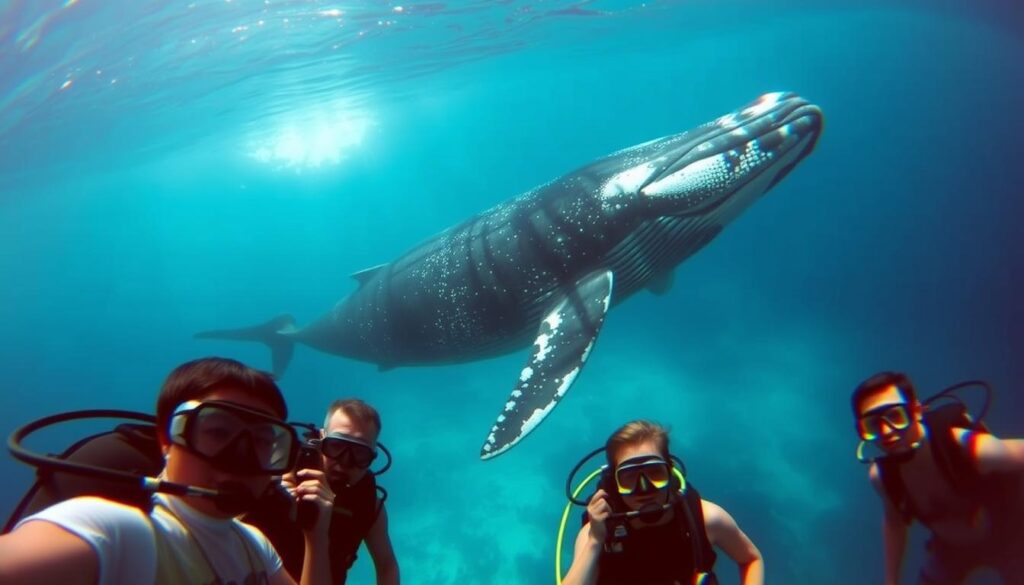
Memorable Experiences with Humpbacks
Experiences with humpback whales show their stunning beauty. Divers share amazing stories of close encounters. Some highlights include:
- Eye contact with a humpback whale just a few feet away
- Witnessing two courting whales in shallow reef waters
- Observing massive tails measuring 10 to 12 feet wide
- Waiting in buoy mode for up to an hour for a possible encounter
“The moment a humpback whale looks directly at you, time seems to stand completely.
Lessons Learned from the Ocean
Encounters with humpback whales teach divers a lot. They learn about marine ecosystems and how to respect wildlife. Important rules include staying at least 100 yards from whales and 300 yards from mother-calf pairs.
Inspiring Conservation Efforts
These close experiences inspire a strong commitment to marine conservation. Divers who see humpback whales’ grace and smarts become dedicated to protecting them.
South Africa’s east coast is a great place for humpback whale sightings. It offers divers chances to see these amazing creatures during their winter migration.
The Science of Humpback Whales
Humpback whales are truly amazing, drawing the attention of scientists and sea lovers. Their long migrations cover thousands of miles, linking different sea areas worldwide.
Migration Patterns and Habitats
Humpback whales make incredible journeys between their breeding spots and where they eat. They can travel up to 5,000 miles each year. They move through huge parts of the ocean with amazing accuracy.
- Winter breeding grounds: Tropical and subtropical waters
- Summer feeding areas: Polar and subpolar regions
- Average migration distance: 3,000-5,000 miles
Unique Characteristics of the Species
Every humpback whale has special features that make them stand out. Their huge bodies and detailed color patterns help scientists tell them apart.
- Spout height: 10-16 feet
- Average body length: 40-50 feet
- Unique fluke markings for individual identification
Humpback Whale Communication
Humpback whales communicate in a complex way. Male humpbacks are famous for their long songs. These songs can last up to 20 minutes and are key in their mating rituals.
“The song of the humpback whale is perhaps the most complex vocal display in the animal kingdom.” – Marine Biologist Dr. Roger Payne
Scientists keep learning about these incredible creatures. They discover more about their behavior, how they talk to each other, and their important role in the sea.
Common Marine Species Found Alongside Humpback Whales
Diving with humpback whales offers not only the chance to observe these magnificent creatures but also the opportunity to encounter a variety of other marine species that share their oceanic habitat. These encounters provide a glimpse into the vibrant and diverse ecosystems where humpback whales thrive. Here are some common marine species you may encounter while diving alongside humpback whales:
- Dolphins: Dolphins are often seen swimming and playing in the same areas as humpback whales. These intelligent and social creatures can be seen leaping out of the water, riding the bow waves, or curiously approaching divers. The acrobatic displays and playful behavior of dolphins add an extra element of joy to your dive experience.
- Manta Rays: Manta rays, with their majestic wingspan and graceful movements, are a sight to behold. These gentle giants often inhabit the same areas as humpback whales, particularly in warm tropical waters. Spotting a manta ray gliding effortlessly through the water is a captivating experience that complements the wonder of diving with humpback whales.
- Whale Sharks: Although more commonly associated with tropical dive destinations, encounters with whale sharks occasionally coincide with humpback whale dives. These magnificent creatures, known as the gentle giants of the ocean, can grow to immense sizes. Observing the slow and majestic movements of a whale shark alongside humpback whales creates an awe-inspiring underwater tableau.
- Turtles: Sea turtles, such as green turtles and hawksbill turtles, are often encountered in the same habitats as humpback whales. These ancient creatures gracefully swim through the water, occasionally coming up for a breath of air. Witnessing a sea turtle gliding alongside a humpback whale adds to the sense of wonder and biodiversity of the dive.
- Reef Fish: The underwater world where humpback whales reside is often teeming with vibrant reef fish. Schools of colorful fish, such as angelfish, butterflyfish, parrotfish, and surgeonfish, can be seen darting in and out of corals and rocky formations. The presence of these smaller fish adds a dynamic and colorful element to your dive experience.
- Cetaceans: Apart from humpback whales, other cetacean species may also be encountered during your dive. Depending on the location, you may have the opportunity to spot other whale species, such as orcas (killer whales), minke whales, or pilot whales. These additional encounters enrich your understanding of the marine environment and the diversity of cetaceans.
- Pelagic Fish: In open water environments, pelagic fish species may be encountered while diving with humpback whales. These include species like tuna, trevally, barracuda, and mahi-mahi. The sight of these fast and powerful swimmers adds an element of excitement to your dive, as they dart through the water in pursuit of prey.
Encountering these marine species alongside humpback whales provides a comprehensive picture of the interconnectedness of oceanic ecosystems. Each species plays a unique role in maintaining the delicate balance of marine life. By observing and appreciating this diversity, you gain a deeper understanding of the intricate web of life beneath the surface.
It’s important to remember that while encountering these marine species can be a thrilling experience, it’s crucial to observe them with care and respect. Maintain a safe distance, avoid touching or disturbing the marine life, and follow responsible diving practices to minimize your impact on their habitat.
Conclusion: The Future of Whale Diving
The global whale watching industry is a mix of adventure and protecting the sea. It attracts over 13 million tourists each year, bringing in $2 billion. This shows how important it is to protect our oceans through tourism.
Divers are key in saving marine life. They help by being good ambassadors for whales. By diving responsibly and supporting safe whale encounters, they help protect the sea.
The Role of Divers in Conservation
New tech like satellite tags has changed whale research. It lets scientists track whales and find important places for them. Divers can help by sharing what they see and joining research projects.
Encouraging Sustainable Tourism
The whale diving world is growing, and we must focus on green tourism. By picking eco-friendly tours and supporting conservation, we ensure whales are around for future generations.
Final Thoughts on Whale Encounters
Every dive with whales is a chance to connect with nature. It’s a time to learn and respect these amazing creatures. We must always remember we are guests in their home.
FAQ – Diving with Humpback Whales
What are the best locations for diving with humpback whales?
Top spots include Tonga, Hawaii, Silver Bank in the Dominican Republic, Mozambique, and Western Australia. Each place offers unique chances to see humpback whales. They migrate between July and October in most areas.
Do I need special certifications to dive with humpback whales?
You don’t need a special whale diving certification. But, advanced open water diving certification and experience are recommended. Many tours require advanced skills and may offer courses for safety.
How close can I get to humpback whales while diving?
Keep at least 15-100 feet away from humpback whales. The exact distance depends on the location and local rules. Always observe without disturbing them.
What equipment do I need for whale diving?
You’ll need a good wet or dry suit, mask, fins, and scuba gear. An underwater camera is optional. Special gear like hydrophones can improve your experience by letting you hear whales.
Are humpback whale encounters dangerous?
Humpback whales are usually gentle and curious. Following guidelines, encounters are safe. But, their size means divers must stay calm and respect their space for a safe experience.
What is the best time of year to dive with humpback whales?
The best time varies by location. Tonga is from July to October, Hawaii from December to May, and the Dominican Republic from January to April. Plan your dive based on the whales’ migration patterns.
How can I support marine conservation during my whale diving trip?
Choose eco-friendly tours, follow marine interaction guidelines, and join local conservation efforts. Avoid touching marine life and consider donating to organizations that protect humpback whale habitats.
What should I do if a humpback whale approaches me?
Stay calm, avoid sudden movements, and keep a neutral position. Don’t touch or chase the whale. If it’s curious, keep a respectful distance and enjoy the encounter while respecting its natural behavior.
